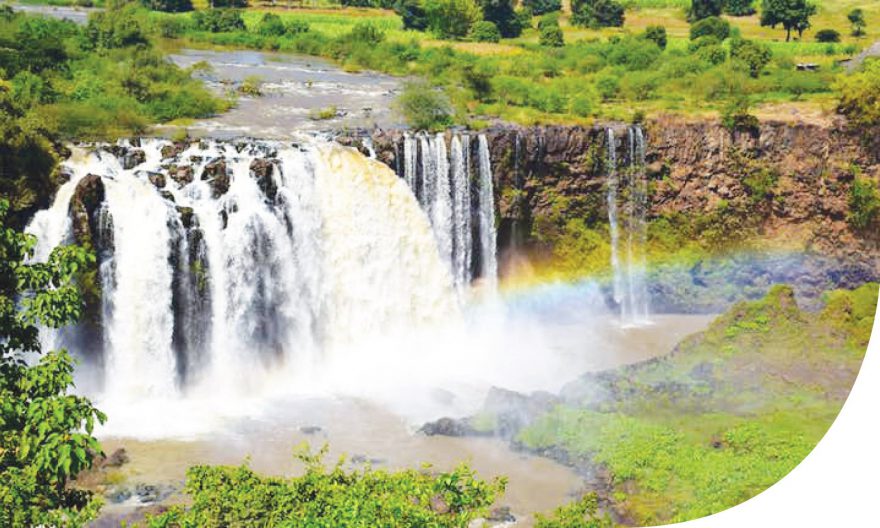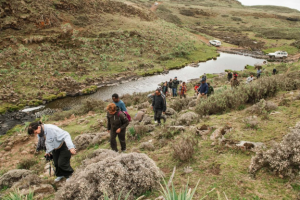
COMPILED BY STAFF REPORTER
Known locally as Tis-Isat Falls – ‘Smoke of Fire’ – is a waterfall on the Blue Nile River in Ethiopia. The Blue Nile Falls is the most dramatic spectacle and breathtaking site in Ethiopia and are considered as one of Ethiopia’s best known tourist attractions.
400 meters (1,312 feet) wide when in flood, and dropping over a sheer chasm more than 45 meters (150 feet) deep, the falls throw up a continuous spray of water, which drenches on lookers up to a kilometer away. As many agreed, the Falls are the most dramatic ones anywhere on the Nile River system, and are at their most impressive in the rainy season from June to early September. Tis Isat, the Blue Nile Falls have isolated ecology Lake Tana from to the rest of the Blue Nile.
The Blue Nile looks like a sluggish beast as it meanders out of Lake Tana, but not far out of Bahir Dar you will see the Nile in a very different mood. The river pours over the side of a sheer 42m-high chasm and explodes into a mélange of mists and rainbows (best at 10am) before continuing on its tumultuous path to Khartoum, where it finally gets to kiss the White Nile.
In the rainy season, when the falls are at their strongest, it is easy to see why the locals call it ‘Tis Abay’ meaning ‘the Great Smoke’ in Amharic.
This misty deluge produces rainbows, shimmering across the gorge, and a small perennial rainforest of lush green vegetation, to the delight of the many monkeys and multicolored birds that inhabit the area.
After leaving the village the footpath meanders first beside open and fertile fields, and then drops into a deep rift that is spanned by an ancient, fortified bridge built in the seventeenth century by Portuguese adventurers and still in use. After a thirty-minute walk, a stiff climb up a grassy hillside is rewarded magnificent view of the falls, breaking the smooth edge of the rolling thundering cataract of foaming water.
The paths that lead to the falls wind through beautiful, verdant countryside and across a 17th century bridge (the first bridge to span the Blue Nile). There are a few routes to choose from, and it is an hour or so each way.
Not only the Falls but also, the countryside around the falls is a great birding destinations. There are a number of endemic species in the area, including the Wattled Ibis.
The best season to visit the waterfall at its biggest and best is in the wet season, August and September are particularly good months. The heavy downpours during the rainy season ensure that the river is sufficiently topped-up to offer a spectacular cascade.
For holidaymakers in Ethiopia at any time of year other than August and September, the Blue Nile Falls, although not as powerful, is still worth a visit because of the beautiful natural surroundings.
“Blue Nile Falls, known as Tis Abay to Ethiopians, was a great attraction to go to. We did not have a guide but we did have local villagers that took us to the location because you have to climb/hike for a while. The hike was not too hard but we had a bunch of village kids following us. I suggest you bring a lot of water, especially if you go in the summer time as it gets really hot. Once we got to Abay, it was amazing. We lucked out because it had been raining that month and as a result there was a lot of water at the Falls. But the locals told us that not a lot of water comes down during the months of April or May. While we were leaving we bought a flute and a beautiful necklace from the kids,” wrote a tourist who got a chance to visit this magnificent and awe-inspiring site.
As sources indicate, the site overlooking the waterfall has been visited over the years by many notable travelers, including the Scottish traveller James Bruce, travel writer who spent more than a dozen years in North Africa and Ethiopia, and recently by the Britain’s Queen Elizabeth II.
THE ETHIOPIAN HERALD JULY 23/2021





